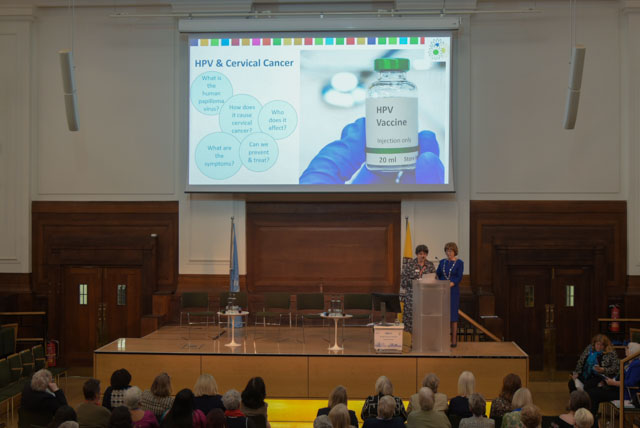Blog by Jennie Walker, SI St Austell and District, South West and Channel Islands
This presentation was made by President Cathy and Soroptimist Lindsay Green.
The Problem!
“One woman dies of cervical cancer every two minutes. Each one is a tragedy, and we can prevent it.”
Dr Tedros Adhanom Ghebreyesus
Director-General World Health Organisation
Africa is the hardest hit region of the world but even countries within our Soroptimist International Great Britain and Ireland (SIGBI) federation are affected, with Jamacia being the hardest hit. Southern Africa has the highest mortality rate in the world and yet Rwanda is the 1st country to eliminate cervical cancer, so we know that this is possible.
Cervical cancer is both preventable and curable. The global elimination strategy requires that
- Vaccination of Girls is at 90%
- High quality screening is at 70%
- Access to widespread high-quality treatment is at 90%
Cathy and Lindsay reminded us that this will not be an easy battle but likened the proposed Soroptimist ‘fight’ with cervical cancer to the Rotary Club fight with Polio (which was successful).
Success of the Global Strategy to Eliminate Cervical Cancer as a Public Health Strategy means:
- Averting over 62 million cervical cancer deaths by 2120. With the status quo deaths are projected to reach 1.2 million annually in low and middle income countries in the same period
- Future generations are protected. Young children are put at risk, their very survival often truncated, by the premature loss of their mothers due to cervical cancer
- Money saved. Hundreds of thousands of women will remain productive members of the workforce adding billions to the global economy.
They then talked about the Health 4 Life Fund. This is the only UN-wide Trust Fund devoted to mental health and non-communicable diseases (NCDs) e.g. cancers and their development dimensions.
The fund creates global financing partnership with low and middle-income countries to reduce premature and preventable loss of life and productivity in line with SDGs 3 and 4.
The fund promotes country ownership by responding to locally identified needs to:
- Stimulate multi-stakeholder and cross-sectoral action
- Increase domestic funds and their efficient use
- Achieve scale for innovative actions that improve population health
The Trust Fund will provide catalytic funding to countries for their priorities under 4 pillars:
- Integration
- Risk Factor Prevention
- Strengthening Health systems and Integrated Services
- Disease elimination
Pillar 4 is the most relevant for the elimination of cervical cancer.
Cathy and Lindsay explained that this strategy requires ‘bodies on the ground’ to raise awareness of cervical concern in Africa and beyond. They believe that all soroptimists can engage in this strategy.
Engaging communities and reaching the most in need is essential!
The health of women and girls is the cornerstone for prosperous families, communities and societies.
This is aligned with our mandate to Educate, Empower and Enable women.
Educating women on cervical cancer will empower them to take informed decisions for theirs and their children’s life-long health, allowing them to reach their full potential.
The partnership enables women across Soroptimist International to take an active role in eliminating a cancer affecting women. Every Soroptimist can own this goal!
We must unite for a common cause and we must unite to save lives!
Facts:
- 99% of cervical cancers are associated with the Human Papilloma Virus (HPV)
- 7 in 10 women have had HPV in their lifetime
In the UK screening started in the 1960s and yet we still have 3,200 cases of cervical cancer a year. 1 in 3 women do not take up their screening appointment!
Research by Kings College showed that only 12% of women understood about HPV screening.
The WHO recommends HPV vaccination but still large parts of the world do not have this available to them. The target for 2030 is to have 194 countries to have access.
Cathy and Lindsay explored the common myths surrounding vaccination and HPV:
- Vaccinating against HPV will cause my daughter to be sexually active
- If you don’t have sex you don’t get HPV
- Only women can get HPV
- HPV vaccination causes infertility
- If you have had the HPV vaccination you don’t need PAP smears
- HPV is rare
- All types of HPV will cause cancer
- Cervical cancer is hereditary
- Cervical cancer affects older women
So how can Soroptimists help?
ADVOCATE!
Support the WHO Global Strategy as a Public Health Programme
FUNDRAISE!
The targets are achievable and within reach of countries IF the necessary resources are mobilised and allocated efficiently for Africa and other federations with Health4Life Funds.
RAISE AWARENESS!
Use opportunities and changes for increasing vaccination and screening
So… what’s next?
A Soroptimist working party has been set up and it is proposed that they will fact find in order to direct their work.
They finished their session by sharing 2 QR codes that delegates could use to sign up to the Global Declaration to Eliminate Cervical Cancer and to show their support for ending cervical cancer. They also suggested that clubs build these messages into their 16 days of activism campaigns as it was in November 2020 that 120 countries signed up at the WHO Assembly to this global strategy. They finally reminded delegates that there is a day of awareness in January for the UK and USA that delegates could participate in.


